Arecibo barrio-pueblo
Arecibo barrio-pueblo is a barrio and the administrative center (seat) of Arecibo, a municipality of Puerto Rico. Its population in 2010 was 8,488.[1][4][5][6]
Arecibo barrio-pueblo Barrio Pueblo Arecibo | |
|---|---|
Municipality Seat[1] | |
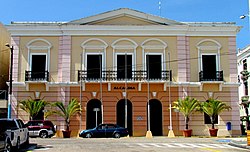 Town Hall in Arecibo | |
 Location of Arecibo barrio-pueblo within the municipality of Arecibo shown in red | |
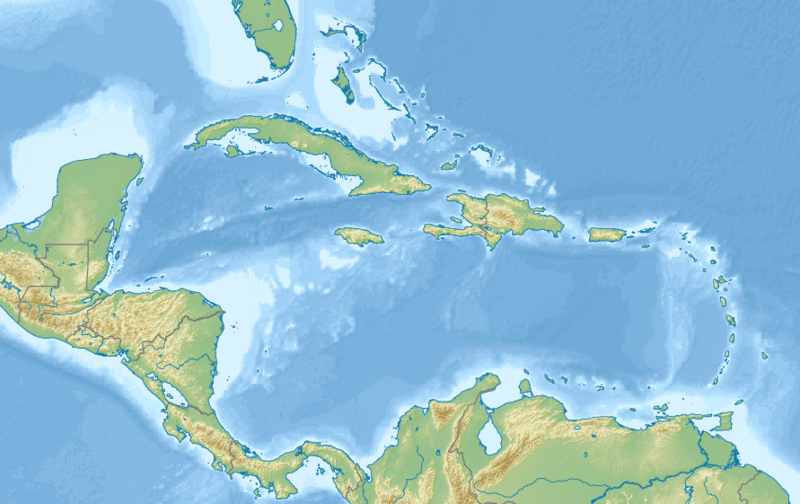 Arecibo barrio-pueblo Location of Puerto Rico | |
| Coordinates: 18°28′23″N 66°43′13″W[2] | |
| Commonwealth | |
| Municipality | |
| Area | |
| • Total | 2.62 sq mi (6.8 km2) |
| • Land | 1.41 sq mi (3.7 km2) |
| • Water | 1.21 sq mi (3.1 km2) |
| Elevation | 23 ft (7 m) |
| Population (2010) | |
| • Total | 8,488 |
| • Density | 5,935.7/sq mi (2,291.8/km2) |
| Source: 2010 Census | |
| Time zone | UTC−4 (AST) |
As was customary in Spain, in Puerto Rico, the municipality has a barrio called pueblo which contains a central plaza, the municipal buildings (city hall), and a Catholic church. Fiestas patronales (patron saint festivals) are held in the central plaza every year.[7][8]
History
The United States took control of Puerto Rico from Spain in the aftermath of the Spanish-American War under the terms of the Treaty of Paris of 1898. In 1899, the United States conducted its first census of Puerto Rico finding that the population of Arecibo Pueblo was 8,008.[9]
The central plaza history
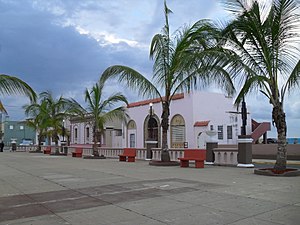
The central plaza, or square, is a place for official and unofficial recreational events and a place where people can gather and socialize from dusk to dawn. The Laws of the Indies, Spanish law, which regulated life in Puerto Rico in the early 19th century, stated the plaza's purpose was for "the parties" (celebrations, festivities) (Spanish: a propósito para las fiestas), and that the square should be proportionally large enough for the number of neighbors (Spanish: grandeza proporcionada al número de vecinos). These Spanish regulations also stated that the streets nearby should be comfortable portals for passersby, protecting them from the elements: sun and rain.[7]
Places of interest
Casa de la Diosa Mita (The House of Goddess Mita), a house listed on the National Register of Historic Places, is located in Arecibo barrio-pueblo. It was the home where Juanita "Mita" García Peraza started the Mita Congregation.
Sectors
Barrios (which are like minor civil divisions)[6] in turn are further subdivided into smaller local populated place areas/units called sectores (sectors in English). The types of sectores may vary, from normally sector to urbanización to reparto to barriada to residencial, among others.[10][11][12]
The following sectors are in Arecibo barrio-pueblo:[13][14]
Avenida 65 de Infantería, Avenida Constitución, Avenida Cotto, Avenida San Luis, Calle Los Héroes, Calles: Ledesma, Cruz Roja, Caribe, Avenida Miramar, Comunidad Barrio Obrero, Comunidad La Múcura, Condominios del Atlántico, Reparto Cotto Viejo, Reparto San Juan, Residencial Bella Vista, Residencial Extensión Zeno Gandía, Residencial Ramón Marín, Residencial Trina Padilla, Urbanización Centro Urbano, Urbanización Radioville, and Urbanización Zeno Gandía.
Gallery
 Passive park Parque Doctor Rivera Aulet
Passive park Parque Doctor Rivera Aulet Building in Arecibo barrio-pueblo
Building in Arecibo barrio-pueblo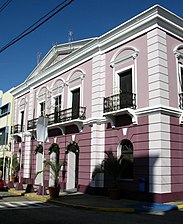 Side view of Town Hall in Arecibo barrio-pueblo
Side view of Town Hall in Arecibo barrio-pueblo.jpg) Plaza and Cathedral in Arecibo
Plaza and Cathedral in Arecibo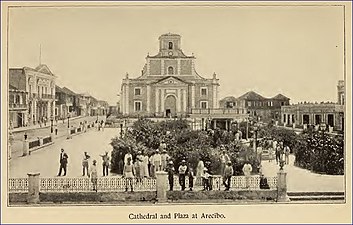 Cathedral and Plaza in Arecibo circa 1899
Cathedral and Plaza in Arecibo circa 1899
See also
References
- Puerto Rico:2010:population and housing unit counts.pdf (PDF). U.S. Dept. of Commerce, Economics and Statistics Administration, U.S. Census Bureau. 2010.
- "US Gazetteer 2019". US Census. US Government.
- U.S. Geological Survey Geographic Names Information System: Arecibo barrio-pueblo
- Picó, Rafael; Buitrago de Santiago, Zayda; Berrios, Hector H. Nueva geografía de Puerto Rico: física, económica, y social, por Rafael Picó. Con la colaboración de Zayda Buitrago de Santiago y Héctor H. Berrios. San Juan Editorial Universitaria, Universidad de Puerto Rico,1969.
- Gwillim Law (20 May 2015). Administrative Subdivisions of Countries: A Comprehensive World Reference, 1900 through 1998. McFarland. p. 300. ISBN 978-1-4766-0447-3. Retrieved 25 December 2018.
- "US Census Barrio-Pueblo definition". factfinder.com. US Census. Archived from the original on 13 May 2017. Retrieved 5 January 2019.
- Santullano, Luis A. (10 March 2019). Mirada al Caribe. 54. Colegio de Mexico. pp. 75–78. doi:10.2307/j.ctvbcd2vs.12. JSTOR j.ctvbcd2vs.12.
- Pariser, Harry S. (2003). Explore Puerto Rico, Fifth Edition. San Francisco: Manatee Press. pp. 52–55. Retrieved 10 February 2019.
- Joseph Prentiss Sanger; Henry Gannett; Walter Francis Willcox (1900). Informe sobre el censo de Puerto Rico, 1899, United States. War Dept. Porto Rico Census Office (in Spanish). Imprenta del gobierno. p. 160.
- "Agencia: Oficina del Coordinador General para el Financiamiento Socioeconómico y la Autogestión (Proposed 2016 Budget)". Puerto Rico Budgets (in Spanish). Retrieved 28 June 2019.
- Rivera Quintero, Marcia (2014), El vuelo de la esperanza: Proyecto de las Comunidades Especiales Puerto Rico, 1997-2004 (first ed.), San Juan, Puerto Rico Fundación Sila M. Calderón, ISBN 978-0-9820806-1-0
- "Leyes del 2001". Lex Juris Puerto Rico (in Spanish). Retrieved 24 June 2020.
- "PRECINTO ELECTORAL ARECIBO 026" (PDF). Comisión Estatal de Elecciones (in Spanish). PR Government. 19 October 2018. Retrieved 2 August 2020.
- "PRECINTO ELECTORAL ARECIBO 027" (PDF). Comisión Estatal de Elecciones (in Spanish). PR Government. 8 October 2019. Retrieved 2 August 2020.